Different ideas for recruiting and retaining new, young employees.
招聘并留住标识行业新鲜血液的一些不同想法。
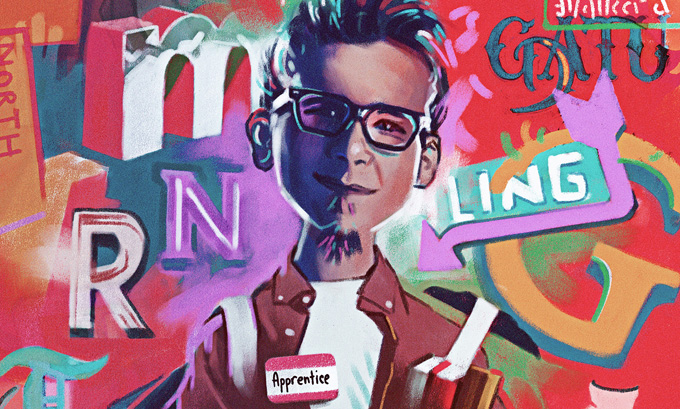
IN HOUSTON, AMERICA’S FOURTH largest city, a recent job for a journeyman sign installer for Federal Heath (Euless, TX) remained open for more than three years. The company’s inability to fill the position, according to Director of Human Resources Ryan Bailey, represents more the rule than the exception, as Federal Heath, a sign company with a national reach, has encountered this difficulty in every city, state and region in which they operate. If Federal Heath can’t find an installer in one of the nation’s largest cities, how are other sign companies faring as they search for new fabricators and installers?
文章开头,先得说一个让人感到不可思议的故事:在美国第四大城市休斯敦,一家业务辐射全美的标识公司——联邦希思公司,他们紧缺的熟练标识安装工的工作岗位已经公开招聘了三年多,至今仍没有稳定的人员填补进去。根据该公司人力资源总监瑞安·贝利的说法,该公司无力填补这一职位的现状是正常的,如果能够正常招聘到位才是不正常的,因为联邦希思公司在全美每个城市、州和地区的分部,都遇到了相同的困难。
这个故事不禁会引起人们的深思:如果这家具有全美影响力的标识公司在美国最大的城市之一里都找不到标识安装工,那么可想而知,其他标识公司在寻找新的标识制造和技术工人时会面临什么样的现状呢?
Anecdotally, the answer seems to be “not very well.” In late August of last year, Bailey joined fellow sign professional Eric E. Larsen, lead designer of the historic theatre marquee division for Wagner Electric Sign Co. (Elyria, OH), to present a webinar, “Recruiting + Training the Next Generation of Signmakers.” The interest on the part of the attendees, their questions and comments suggested that Federal Heath’s challenge in Houston is widely shared.
总之,这个问题的答案似乎是“不太好”。2020年8月下旬,贝利加入了瓦格纳电气标识有限公司首席设计师埃里克·E·拉森举办的一个网络研讨会,主题就是“招聘+培训下一代标识制作人”。与会者们对于联邦希思在休斯敦所面临的窘境非常重视,并提出了很多问题和评论,并将之广泛分享至业界。
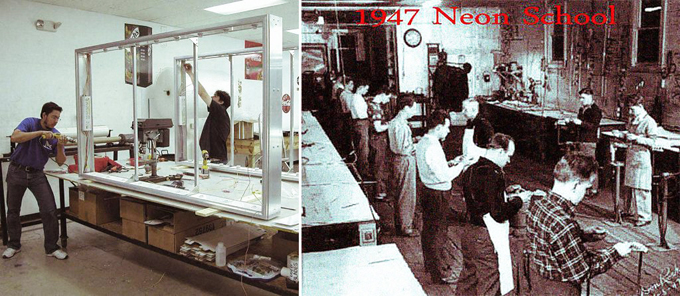
Wagner Electric’s Eric E. Larsen suggests that sign companies resume the practice of offering apprenticeships, as was the case in the photo above from a neon shop in 1947.
瓦格纳电气公司的埃里克·E·拉森建议标识公司恢复提供学徒制,正如1947年一家霓虹灯店的照片上一样。
SOME CAUSES
窘迫现状
How has the industry ended up in this position? Why are we having such difficulty bringing new people, especially young people (who are not family members), into our industry?
标识行业究竟为何会在人们的职业选择中处于现在这样尴尬的位置?为什么将新人,尤其是年轻人(并非家庭成员)代入行业会越来越困难?
One reason seems to be the lack of knowledge among the general public that the sign industry even exists. Though perhaps overstated, ask anyone who’s never worked for a sign company or ordered signs, and they’re not likely to know where signs come from.
根据相关研究,原因之一可能是绝大部分的公众缺乏对标识行业的了解。尽管可能有些夸张,但如果真的去采访一个从未在标识公司工作过或订购过标识的人,他们很可能说不出来标识到底来自哪里。
Many other professions as large as the sign industry aren’t cloaked in such invisibility. So clearly, one major problem is lack of industry self-promotion. Associations can help, but signshops themselves must do a better job of marketing what they do not only to their clients, but also to their communities.
其实,从现实的角度来说,像标识行业这样的许多其他专业并没有故意地隐藏起来,那么为什么仍然让人感觉非常罕见呢?显然,一个主要的问题就是缺乏行业的自我促进意识。当然,一定程度上,地方的标识协会可以帮助改善这样的情况,但标识公司自己的相关工作也必须做得更好——对自己的工作进行营销——不仅面向客户,同时也要面向自身所在社区,辐射更多的公众。
Money solves many problems, but most sign companies are not in the position to raise salaries for fabricators and installers, and even if they were, they still would be hard-pressed to find the individuals with the skillsets to merit higher pay. Those with skills are closely guarded by the companies they work for, with some shops begging their older, experienced installers to stick around, not to retire, or to continue working part-time. This also can work for a while, but not for the long term.
在面临无法招聘到员工的情况下,提高工资固然可以在一定程度上解决许多问题,但大多数标识公司都不会选择去提高标识制造、安装员工的薪水,因为即使他们愿意去提升,也很难找到具有与高薪水相匹配的高技能人才。而这些高技能人才早已被所在的公司牢牢绑定,有些公司甚至恳求已经比较年长,但经验丰富的安装人员不要退休,继续坚持工作,哪怕只是兼职工作也可以。这样的方法当然可以在短时间内保持一家标识公司正常的工作,但绝不可能长期有效。
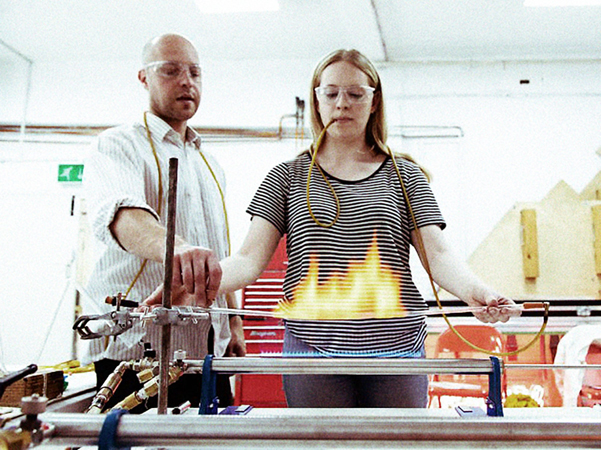
Larsen feels it’s important to show apprentices everthing your sign company does, even if they won’t be doing high-skill work right away.
拉森认为,即使标识公司对于新学徒不会立即有从事高技能工作的要求,也必须向其展示这些高技能工作,这一点很重要。
GET SCHOOLED
从学生,到学徒
So now what? Larsen, the driving force behind the aforementioned webinar, has proposed we return to an age-old system: apprenticeships. Sign companies could recruit from a number of sources, but Wagner Electric will be looking to local high schools, a resource found everywhere. Larsen specifically suggests searching for student-apprentices through high school art teachers.
现状如此,应该如何应对呢?拉森之所以发起线上研讨会,背后的推力就是他建议标识行业回归到一个古老的体系:学徒制。
该制度的优越性在于,标识公司的招聘渠道不再单一,可以从多种渠道招募人才。比如,拉森所在的瓦格纳电气标识公司就与当地的中学合作。类似的资源可以说随处可见。拉森特别建议,通过高中美术老师寻找学徒是比较有效的方式。
The art teachers Larsen has talked to so far raised important, legal steps when contacting students under 18. “The art teachers said to give them what you’re looking for [a paid apprentice for summer], and they would find the kids who might be interested,” Larsen said. The art teacher would get back to the sign company with brief descriptions of kids (no names yet) who might be a good fit based on what they’ve been good at in art class. Next, the sign company would reply to the art teacher as to which student(s) they would like to interview. The art teacher would then approach the student(s) and tell them that a sign company is interested in interviewing them for a summer apprenticeship program, with no obligation. If the student(s) are interested, the teacher then would then contact the parents or guardians of those students, and finally, the parents contact the sign company. “There is a lot of contacting back and forth but these are the rules involving minors,” Larsen said.
拉森在学校招募学徒时,与18岁以下学生的联络一直遵守着法律程序,这一点他非常重视。“首先,在与美术老师达成合作后,他们会先从可能对标识有兴趣的学生中选择。”拉森说道,“随后,美术老师将可能很适合的学生的匿名简介带到标识公司。接下来,标识公司将从简历中挑选并告诉美术老师他们想面试的学生,再由老师与学生接触,并告诉他们标识公司有兴趣与他们面谈暑期学徒计划,但其中没有任何义务成分。如果学生有兴趣,老师会联系其父母或监护人,由他们与标识公司进行招聘商谈。
“尽管这种联系方式有些来来回回的折腾,但这是一旦涉及未成年人劳工后必须遵守的硬性规定。”
Also, obviously, any in-shop apprenticeship program would have to be demonstrably safe from potential exposure to COVID-19, as it would be for all employees.
同样需要遵守的规定还有在新冠疫情期间,学徒计划必须确保所有员工的安全,消除他们可能暴露于病毒的潜在危险。
With students over 18 (most in college, for example), you can approach them directly. Many colleges offer art courses and/or art degrees, and present a viable resource for shops in towns near community colleges or universities.
当面对的学生群体超过18岁时,例如在大学之类的院校招收学徒时,则无需再经过繁琐的步骤,可以直接与他们面谈。许多学院都提供艺术课程或艺术学位,这为社区学院或大学附近城镇的商店提供了丰富的学徒资源。

FOR STARTERS
漫漫前路
While Larsen and Mark Wagner, president of Wagner Electric Sign Co., are committed to a summer apprenticeship program, they are still discussing exactly what an apprentice might do in their full-service shop. No matter where their apprentice starts, Larsen intends to show the young person everything the company does, even though the apprentice won’t yet be performing the more highly skilled work. “Make sure they realize they’re only at the starting point,” Larsen said, “and this is the other stuff they can do once we get them started and they understand it.” Tell them, he said, “If you see something over in the corner that looks like fun to you, by all means we’ll introduce you to it and see how you do. But [first] we’ve got to get them in the door.”
虽然拉森和瓦格纳电气标识公司的总裁马克·瓦格纳都致力于暑期学徒计划,但他们并非盲目地为了招聘人员来干活,而是真正在讨论研究学徒在一家全方位的标识商店中究竟可以做些什么。首先,不管学徒的起点高低,哪怕他们还没有从事更高技能的工作,拉森都打算向这些年轻人展示公司所做和所能做到的一切,他说道:“这是为了确保他们意识到自己尚还处于起点的位置,而在他们眼前展现的,是只要跟从我们的脚步,早晚会接触到的东西。比方说,当一名学徒看到了一些很感兴趣但比较生僻冷门的东西,我们也一定会详细去介绍其工作或生产方式并让学徒自己去试一下,但唯一的要求就是必须先入门。”
Where might apprentices start in a shop? Like any entry-level position – at the beginning. Give them the most basic tasks to start on: cutting vinyl and simple applications. In fact, shops may prefer an apprentice doing the easy stuff to free up full-time fabricators to concentrate on more advanced work. Larsen has already enlisted two other, smaller local signshops in the apprenticeship concept. “The sign companies I’m talking to are on board with it because they’re [saying], ‘We need someone to do vinyl this summer,’” Larsen said.
那么学徒在进入公司后,究竟该从哪‘入门’呢?拉森的答案是,像任何入门级职位一样,一开始从最基本的任务开始:切割乙烯基和简单的产品。实际上,标识公司都会更喜欢从简单工作开始入手的学徒,因为这样可以腾出专业标识制作员工的时间来专注于高技能的工作。拉森的学徒计划还吸引了两家规模较小的本地化标识店,拉森说:“这两家标识公司之所以在我们与之交流后就立即加入,是因为他们在今年夏天需要有人来裁切乙烯基。”
Here’s another way to introduce your shop to young people, but with a less-involved commitment: Sign Manufacturing Day, held annually across the US and Canada on the first Friday in October. This event draws thousands of students to tour sign, graphics and visual communications companies, and to learn more about careers in the industry. Participating students have found permanent jobs, internships and co-ops, and participating companies have built ongoing relationships with educators and schools. The event is sponsored by ISA in conjunction with the National Association of Manufacturers.
在北美还有一个不可错过的方式,可以向年轻人介绍自己的标识公司,而且投入不高,那就是每年10月的第一个星期五在美国和加拿大举行的:标识制造日。这项活动历届都会吸引成千上万的学生去参观标识、图形和视觉信息公司,从而了解有关该行业各职能岗位的更多信息。参加活动的学生可以从中找到长期的工作、实习和兴趣社团;参加活动的公司与教育工作者和学校建立了持续的合作关系。该活动由ISA与美国国家制造商协会共同赞助。
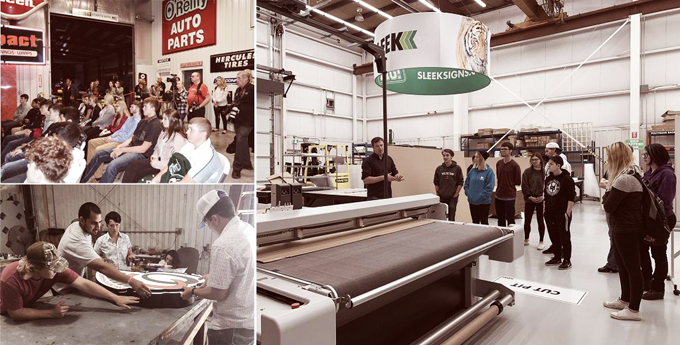
The three photos show sign companies involved in 2019’s ISA Sign Manufacturing Day.
这三张照片都是2019年参与ISA标识制造日的公司的宣传照。
JUSTIFIED
正反思辩
Sure…”I can hear some understandably skeptical readers saying. “But how much time am I going to have to put into training an apprentice, and am I going to get at least that much time back out of them doing sellable work?” Excellent question, and one you can probably already answer by calculating the training period for your most-recent hire or even yourself. Depending on what your shop does, chances are good you can find some kind of work befitting an apprentice.
当然,一些可以理解的怀疑论者也会说:“那么我要花费多长时间去训练一个学徒呢?我能够从这些时间中获得可以盈利的回报吗?”这些都是很好的问题,不过这些问题都可以通过最近的员工招聘培训时间或者自己的学习时间计算出来。虽然不同的商店有着不同的工作情况,但是找到适合学徒的工作还是不难的。
“Okay,” you may say. “What if they quit or leave at the end of the summer and don’t come back?” Less excellent this time. Are these not the risks of every new hire? Also, don’t many companies hire kids for summer jobs with no expectation of their staying on? Besides, as Larsen said, “If we don’t take those chances, we’re not going to find out and we’ll be stuck in the same boat.”
那么怀疑论者可能又会提出新的问题:“好吧,就算有合适的工作,但是我们培养了他们一个暑期,他们在此阶段结束后离开也不再回来了怎么办呢?”不可否认,这的确不太妙。但话说回来,这些问题在新员工的招聘上不是一直存在的风险吗?另外,有很多公司雇佣学生从事暑期工作本身就打的是临时算盘,并没有留下他们的期望。此外,正如拉森所说:“整个标识行业其实都在一条船上,如果我们不抓住这些机会尽可能培养出标识行业的下一代,我们都将被困住。”
Now here’s a question for the skeptics: What if the apprentice does produce more hours of sellable work than your hours spent on training? What if they like the job and stay for the entire summer? “Some kids may even decide at the end of the summer that they want to keep working for the sign company, after school or on the weekends,” Larsen said. Some apprentices – the high school seniors – will likely have already graduated by the time they are starting in the summer. Some may either not be, or not yet be, continuing with college, and they could be open to staying on. Even those attending college in the area may want to continue to work while going to school.
反过来,现在给怀疑论者提出一个问题:如果学徒的确能够在培训所花费的时间里作出更多的有价值的工作,那该怎么办?如果他们喜欢标识行业的工作并且度过了整个夏天而且仍将继续,那又怎么说?拉森说道:“有些学生甚至可能在暑期尾声时决定放学后或者在周末继续为标识公司工作。”此外,一些高中生学徒,很可能正好处于高中毕业的暑假,他们中一部分可能会读大学,一部分可能不会:不读大学就面临着进入社会谋生的问题,他们很可能会继续留任从事标识行业;而读大学的人中,有一部分会在本地大学读书,这些人也会希望在上学时继续工作。
More potential benefits: “The kids who are in the program – some will tell their friends,” Larsen said. “Word of mouth travels fast with kids.” Sounds like the kind of promotion the sign industry needs.
拉森表示:“更多的潜在好处还有:身处标识项目中的学徒们,将会把有趣的经历分享给他们的朋友,这样良好的口碑在孩子们中间传播得很快。”这也是标识行业所需要的一种促销方式。
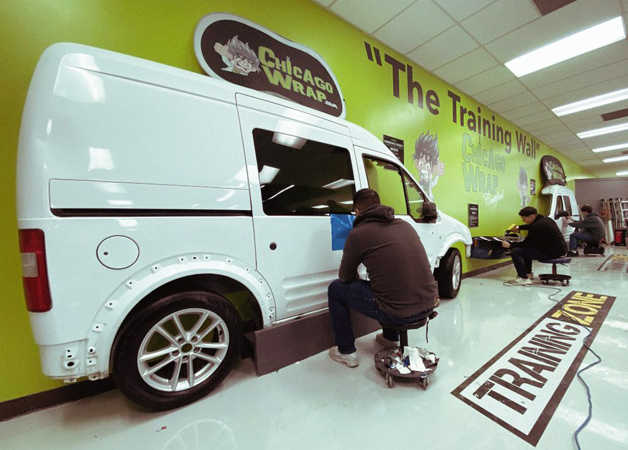
Sean Heffner’s Chicago Wrap University makes excellent aftermarket use of the shop’s old Transit van that had dropped its transmission. Now it functions as a training tool.
肖恩·赫夫纳创办的“芝加哥包装大学”很好地将该店的旧式厢型车做了废物利用,这辆车变速箱报废了,但是现在可以用作汽车贴膜的培训工具。
PAY TO PLAY
付费学习
Now for something not completely different, but certainly different enough from the paid-apprentice concept. Sean Heffner, owner of Chicago Wrap (Naperville, IL), also brings new people into his company – but they pay him for training. “The [Chicago Wrap] university is definitely a big thing,” Heffner said. “In one year I’ve probably gotten 60 people into the industry and I’ve hired three or four of them. What I’ve realized is that there’s no one really out there giving that true wrap-shop training.”
现在还有一些新式的学徒计划与一般的带薪实习内容上没有什么根本的区别,但其不同点也值得关注。芝加哥包装公司的老板肖恩·赫夫纳也在招募学徒进入他的公司,但却是学徒给他付钱,以期获得专业的培训。赫夫纳说:“‘芝加哥包装大学’绝对是一件大事。在一年的时间中,我通过这个计划可能至少吸引了60名员工进入该行业,而我自己雇佣了其中3-4名。在此期间我意识到,在外面的很多培训课程里,几乎没有人真正提供过包装车间的实训。”
Heffner’s father, Mike, originally a pinstriper, started the company in 1980, and a few years ago, recognizing the shortage of skilled wrappers, he and Sean slowly built a training program. They started with one of shop’s old Transit vans, which had lost its transmission. “Rather than just get rid of it, we stripped it, cut it in half and built this wrap course,” he said. Now, Chicago Wrap University offers both at-home courses as well as in-shop, hands-on training.
肖恩·赫夫纳的父亲迈克是一位精打细算的商人,于1980年创立了这家公司。几年前,迈克和肖恩由于认识到熟练的车辆包装工人面临短缺的情况,他们开始着手慢慢建立培训计划——从商店里一辆过时的、失去运输能力的货车开始。迈克回忆说:“我们不仅仅是剥离它,而是将其拆解,切割成两半并建造了一整套的包装流程。”现在,“芝加哥包装大学”提供室内教学以及店内动手培训。
They’d been at it a couple of years when, in 2018, Heffner decided to accompany his best friend, who was changing careers, to an Avery Dennison wrap seminar in Miami. “With 17 years of experience I went to the class and I learned a lot beyond just how to put wraps on,” Heffner said. “What I learned personally was humility. That was from Justin Pate, and that’s what [further] sparked my interest.” Upon his return home, Heffner looked to improve the wrap course.
培训计划的建立经历了几年的时间,2018年,赫夫纳决定陪伴他一个正在转行的好朋友去参加在迈阿密举行的艾利丹尼森包装研讨会。赫夫纳说:“凭借17年的专业经验,我在课堂上很快上手,不仅学到了如何进行包装,而且还学到了很多其他的东西,比如谦卑,来自贾斯汀·佩特的教诲。这进一步激发了我的兴趣。”
在研讨会结束返回家乡后,赫夫纳决定为自己的包装程序升级。
COURSE OF ACTION
实训课程
The first thing Heffner realized at the seminar in Miami was that two days isn’t enough, so Chicago Wrap extended their training to two weeks. The first week emphasizes classroom training and the fundamentals of vinyl. “Then we get [students to start applying vinyl] on the wall, so they’re going back and forth, which is similar to the [manufacturers’] class,” Heffner said. “We keep pounding the fundamentals into them, and then for the second week, we get them working on an actual car, usually one of our customers’ vehicles. Now they’re getting actual experience, real-life certification, and when they’re done, they feel like they did the car,” he said, adding, “It’s very important to get that first wrap under your belt, and then you just keep going.”
赫夫纳在为其两天的迈阿密研讨会上意识到的第一件事就是:仅仅两天对于培训来说是远远不够的。因此在其创办的“芝加哥包装大学”,培训周期延长到了两周。第一周着重于课堂培训和乙烯基基础知识,“然后,我们让学生开始在墙面上贴涂乙烯基材料,让他们动起手来,这就和制造培训班相类似了。当然,第一周还是研究基本原理,到了第二周,学员们就开始在实际的汽车上工作,通常都会是真实的客户车辆。这时他们就会获得实际的工作经验,投入到真实的商业活动中。但他们完成工作后,就会觉得自己能够主宰一切。”赫夫纳说道。他又补充说:“学员的第一次包装非常重要,必须放在心上。一旦成功完成,那么后续的路都会顺畅。”
Once students complete the course, they can come back and, with guidance, wrap another vehicle. “I give them the opportunity to do their own vehicle or their first customer’s,” Heffner said.
在学员完成所有的课程后,他们可以选择在公司的帮助下对另一辆车进行包装。赫夫纳说:“这样就给了他们对自己的汽车进行包装或获取第一个客户的机会。”
“It’s almost like an extra for the course, because we want to stand behind these guys and answer for our certification.” Heffner sees this as differentiating Chicago Wrap U. from manufacturers’ training and certification, which, after their seminars, generally allow their students a year to earn their certifications. “We deliver that at the end of the second week,” Heffner said.
“这就是我们所提供的课程的额外内容了,我们也确实希望能够作为这些学员的支持,从而以他们的优秀工作为我们的课程打响招牌。”赫夫纳认为,这是“芝加哥包装大学”与传统制造商的培训和认证最大的不同点:在后者的培训结束后,他们的学生要花费至少一年来获得认证,然而,“我们将在第二周结束时就将这个认证交给学员。”赫夫纳说。
As proof, he related an anecdote of some of his graduates who went to 3M for certification on installing clear bra. Heffner said his students passed on their first try despite the instructors’ having insisted that a background of five years in wrapping would be necessary. “Where the hell did you learn to wrap?” the instructors are reported to have said.
为了他们提供这个认证的证据,赫夫纳提供了一些毕业生的轶事,这些毕业生在课程结束后去了3M并获得安装透明车头照的认证。赫夫纳说,尽管3M的导师坚持要求获得认证必须有五年以上的车辆包装经验,但毕业于“芝加哥包装大学”的学员还是以此通过了考试。这弄得3M导师非常惊讶:“你到底在哪里学习车辆包装的?”根据新闻报道来看,导师们获得了答案。
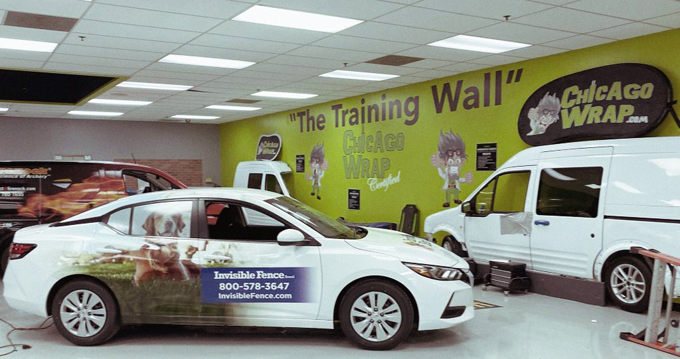
Heffner’s course allows graduates to return after completing the two-week training to wrap their own vehicle or their first customer’s.
赫夫纳的课程允许学员在为期两周的课程毕业后为自己的车辆进行包装或接触第一位客户。
NETWORK OF SUCCESS
组建成功网络
When asked, aren’t you just training your competition? Heffner answered, “That’s what everyone says. The way I look at it is, the wrap industry is in need of installers and a wrap company needs installers more than [any other kind of employee].” He said he’s encountered some “arrogant people,” who have opened wrap shops in his area, but he’s not bothered. “I want more people to do it,” Heffner said. “Competition is always going to be out there. [To succeed], it comes down to knowing how to run a business.”
当被问到,您这样做不是在训练自己的竞争对手吗?赫夫纳回答说:“大部分人都会这么说。但我的看法是,车辆包装行业需要安装人员,而包装公司对安装岗位员工的需求远大于其他类型的员工。”赫夫纳遇到过一些“自大的人”,他们在他的“地盘”开设了车辆包装店,但赫夫纳并不为此困扰,“相反,我希望更多的人去从事这个行业。”赫夫纳说,“竞争总是会存在的,而要在竞争中胜出,就取决于知道如何开展业务。”
He credits the commitment to his installers for putting him in a position to teach. “And it’s the most profitable part of my business right now,” he said. In addition to the revenue, Chicago Wrap’s graduates also comprise a network of installers Heffner can call upon. “Sometimes I’ve had more installers than I can use, sometimes less, but there’s nothing worse than having to turn down a job because you don’t have enough installers,” he said. “And when you get jobs, deadlines are tight,” as was the case with a big job for the 2019 Chicago Auto Show.
赫夫纳将他执教的动力归功于学员的学费,他说:“尽管我自己从事着汽车包装工作,但‘芝加哥包装大学’是我目前业务中最赚钱的部分。”除了学费收入外,毕业的学员还能为赫夫纳带来可以支配的工作网络,“有时候我手边有超出工作量的安装人员,有些时候则人手不足。但是无论在何种情况下,没有什么会比由于没有足够忍受而不得不拒绝一份工作更糟糕的了。”赫夫纳说道,“而且包装行业通常在接下工作后的很短时间就面临交付。”2019年芝加哥车展时赫夫纳所承包的重要项目就是这样。
Should other companies follow this lead? “If they’re big enough and can take on the responsibility and have the facility and the installers… it would be beneficial to them because they’re going to bring in more people and build their own networks,” Heffner said.
既然这种模式能够带来良好的效应,那么其他公司应该效仿吗?赫夫纳对此的解释是:“如果他们足够强大,能够承担起各项设施和安装人员···毫无疑问效仿这种模式能够带来利处,因为他们将吸引更多的人并建立自己的网络。”
Like many in the sign industry, Heffner was born into it, but we can’t continue to allow that to continue to be the best or primary means to enter the field. “There are a lot of kids out there interested in this industry,” he said, “but I don’t think they know what to do.”
Now, hopefully, you have a few ideas.
像许多标识从业者一样,赫夫纳能进入标识行业也是应运而生的,但很明显这种方式不能继续让它继续成为新血液进入该领域的最佳或主要手段,赫夫纳说道:“有很多孩子对该行业感兴趣,但我不认为他们知道如何正确进入该行业。”
希望这篇文章能够对看到的人有所启发。








